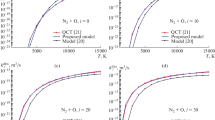Abstract
The paper proposes an effective algorithm for solving problems of nonequilibrium gas dynamics taking into account detailed state-to-state vibrational kinetics. One of the problems of traditional methods is their high computational complexity, which requires a lot of time and memory. The work explored the possibilities of using relaxation rate prediction to improve the performance of numerical simulations of nonequilibrium oxygen flows instead of direct calculations. For this purpose, an approach based on a nonlinear regression analysis was used, which made it possible to obtain computationally efficient approximation formulas for the energy exchange rate coefficients in the model of a Forced Harmonic Oscillator, taking into account free rotations (FHO-FR), to significantly increase the calculation speed while maintaining accuracy, and to construct an optimized model FHO-FR-reg. Using the obtained regression formulas, numerical modeling was carried out, which made it possible to validate the model for the problem of oxygen flow behind an incident and reflected shock wave. A comparison between the Forced Harmonic Oscillator (FHO) and the FHO-FR models is not possible due to the high computational complexity of the second model. With the advent of a common approximation model, it became possible to compare simulation results for these models. Numerical calculations have shown that the FHO-FR–reg model gives values of gas-dynamic parameters close to the FHO model. The developed regression models make it possible to speed up the solution to the problem of modeling oxygen relaxation several times compared to other models of similar accuracy.


Similar content being viewed by others
Notes
STS-Simple-Solver. URL: https://github.com/MaksimMelnik/STS-Simple-Solver (Accessed data September 1, 2023).
REFERENCES
E. A. Nagnibeda and E. V. Kustova, Nonequilibrium Reacting Gas Flows. Kinetic Theory of Transport and Relaxation Processes (S.-Peterb. Gos. Univ., St. Petersburg, 2003; Springer-Verlag, Berlin, 2009), in Ser.: Heat and Mass Transfer.
O. V. Kunova, E. V. Kustova, M. Yu. Melnik, and A. S. Savelev, “Validation of Models of State-to-State Oxygen Kinetics behind Shock Waves,” Physical-Chemical Kinetics in Gas Dynamics 19 (3) (2018). http://chemphys.edu.ru/issues/2018-19-3/articles/765/
L. Campoli, O. Kunova, E. Kustova, and M. Melnik, “Models validation and code profiling in state-to-state simulations of shock heated air flows,” Acta Astronaut. 175, 493–509 (2020). https://doi.org/10.1016/j.actaastro.2020.06.008
D. S. Kravchenko, E. V. Kustova, and M. Yu. Melnik, “Modeling of state-to-state oxygen kinetics behind reflected shock waves,” Vestn. St. Petersburg Univ.: Math. 55, 281–289 (2022). https://doi.org/10.1134/S1063454122030104
R. N. Schwartz, Z. I. Slawsky, and K. F. Herzfeld, “Calculation of vibrational relaxation times in gases,” J. Chem. Phys. 20, 1591–1599 (1952). https://doi.org/10.1063/1.1700221
I. Adamovich, S. Macheret, J. Rich, and C. Treanor, “Vibrational energy transfer rates using a forced harmonic oscillator model,” J. Thermophys. Heat Transfer 12, 57–65 (1998). https://doi.org/10.2514/2.6302
I. Adamovich and J. Rich, “Three-dimensional nonperturbative analytic model of vibrational energy transfer in atom-molecule collisions,” J. Chem. Phys. 109, 7711–7724 (1998). https://doi.org/10.1063/1.477417
I. Adamovich and J. Rich, “Three-dimensional analytic model of vibrational energy transfer in molecule-molecule collisions,” AIAA J. 39, 1916–1925 (2001). https://doi.org/10.2514/2.1181
S. F. Gimelshein, I. J. Wysong, and I. V. Adamovich, “Application of the 3D forced harmonic oscillator model in the DSMC method,” J. Thermophys. Heat Transfer 32, 882–891 (2018). https://doi.org/10.2514/1.T5228
V. T. Baluckram, A. J. Fangman, and D. A. Andrienko, “Simulation of oxygen chemical kinetics behind incident and reflected shocks via master equation,” J. Thermophys. Heat Transfer 37, 198–212 (2022). https://doi.org/10.2514/1.T6522
M. A. Bushmakova and E. V. Kustova, “Modeling the vibrational relaxation rate using machine-learning methods,” Vestn. St. Petersburg Univ.: Math. 55, 87–95 (2022). https://doi.org/10.1134/S1063454122010022
V. I. Gorikhovskii, Efficient Computational Approaches to Modeling Carbon Dioxide Kinetics, Candidate’s Dissertation in Mathematics and Physics (St. Petersburg State Univ., St. Petersburg, 2022).
L. B. Ibraguimova, A. L. Sergievskaya, V. Yu. Levashov, O. P. Shatalov, Yu. V. Tunik, and I. E. Zabelinskii, “Investigation of oxygen dissociation and vibrational relaxation at temperatures 4000–10800 K,” J. Chem. Phys. 139, 034317 (2013). https://doi.org/10.1063/1.4813070
J. W. Streicher, A. Krish, and R. K. Hanson, “Coupled vibration-dissociation time-histories and rate measurements in shock-heated, nondilute O2 and O2–Ar mixtures from 6000 to 14000 K,” Phys. Fluids 33, 056107 (2021). https://doi.org/10.1063/5.0048059
S. F. Gimelshein, I. J. Wysong, N. G. Bykova, O. P. Shatalov, and I. E. Zabelinskii, “Improved analysis of O2 ultraviolet absorption spectra under nonequilibrium shock conditions,” AIAA J. 58, 4451–4460 (2020). https://doi.org/10.2514/1.J058961
J. W. Streicher, A. Krish, and R. K. Hanson, “High-temperature vibrational relaxation and decomposition of shock-heated nitric oxide. I. Argon dilution from 2200 to 8700 K,” Phys. Fluids 34, 116122 (2022). https://doi.org/10.1063/5.0109109
Funding
The work of A. A. Isakov and V. I. Gorikhovskii was carried out with the financial support of St. Petersburg State University (project ID 94034084), M. Yu. Melnik with the support of Theoretical Physics and Mathematics Advancement Foundation “BASIS” (grant 22-1-1-17-3).
Author information
Authors and Affiliations
Corresponding authors
Ethics declarations
The authors of this work declare that they have no conflicts of interest.
Additional information
Publisher’s Note.
Pleiades Publishing remains neutral with regard to jurisdictional claims in published maps and institutional affiliations.
About this article
Cite this article
Isakov, A.A., Gorikhovskii, V.I. & Melnik, M.Y. Regression Models for Calculating State-to-State Coefficients of the Rate of Vibrational Energy Exchanges. Vestnik St.Petersb. Univ.Math. 57, 226–235 (2024). https://doi.org/10.1134/S1063454124700079
Received:
Revised:
Accepted:
Published:
Issue Date:
DOI: https://doi.org/10.1134/S1063454124700079




